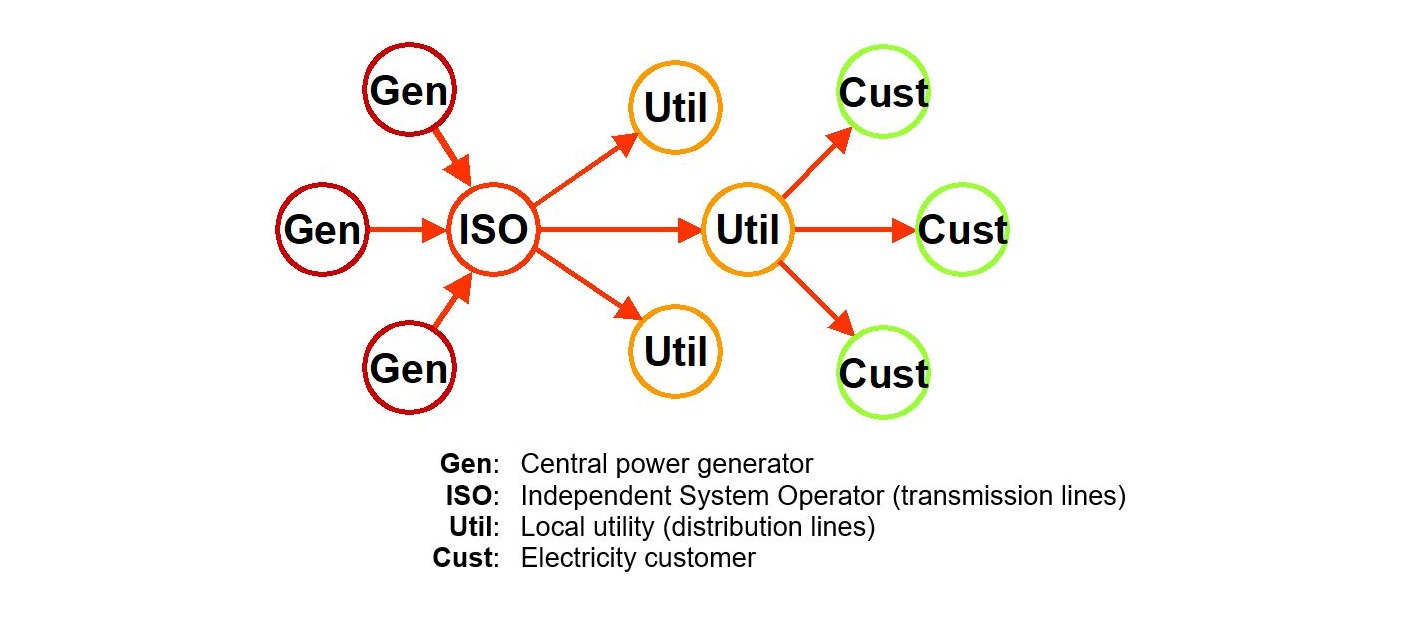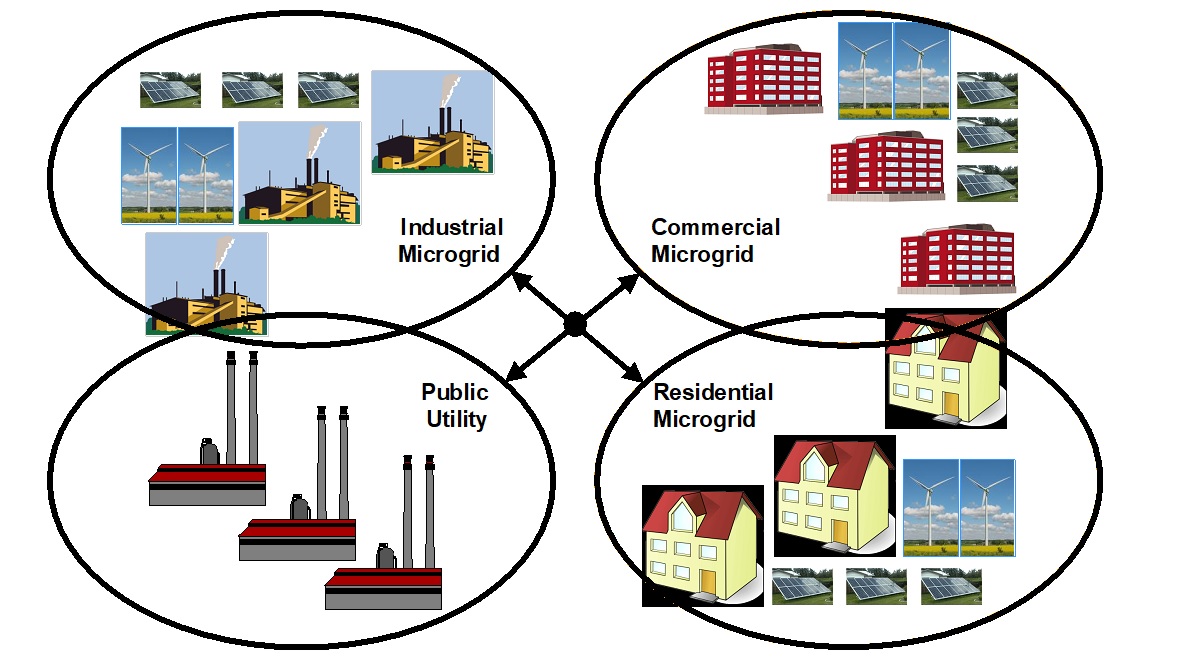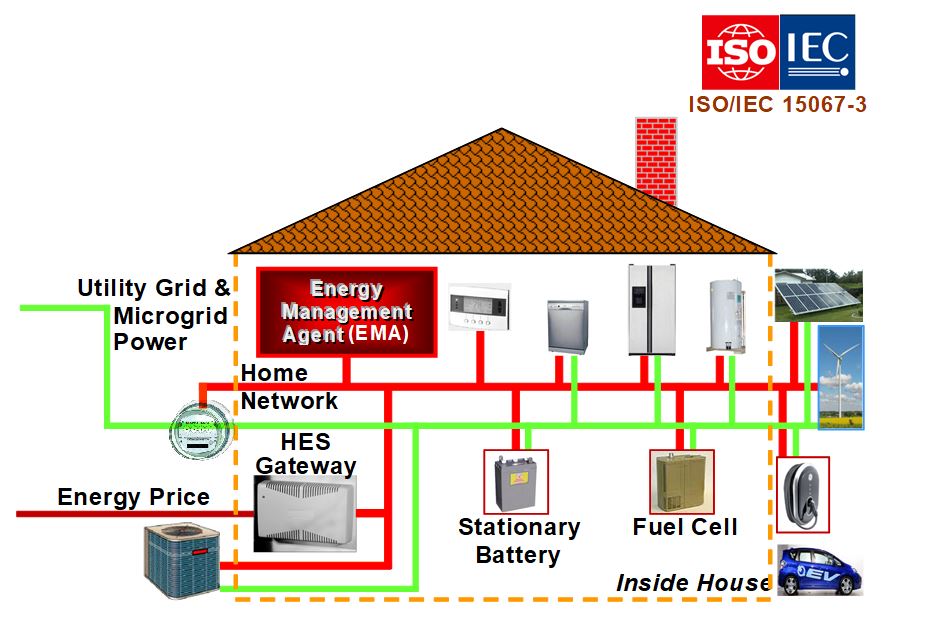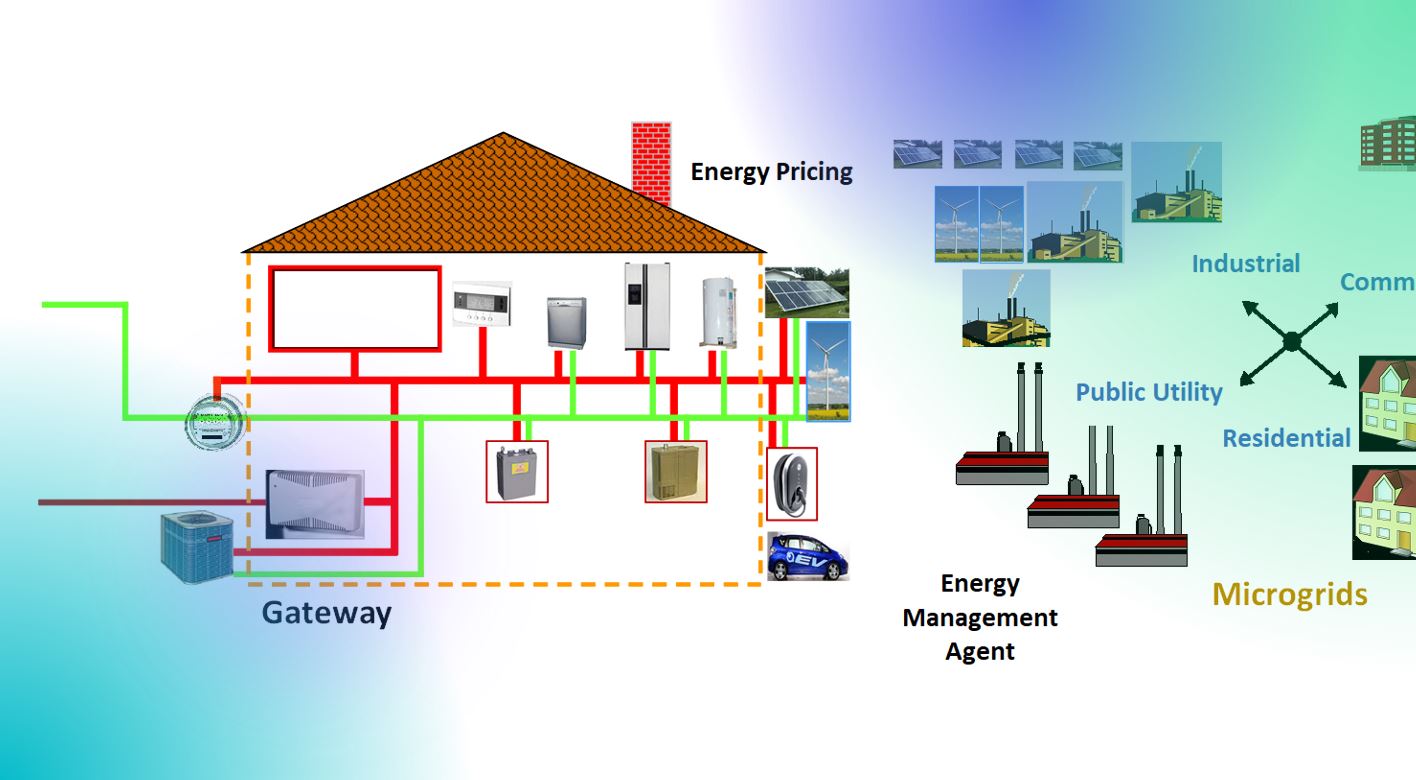This is the second article in a year-long series that premiered in November 2021 on international standards for energy management. These standards support the transformation of the power grid from centralized generation to distributed energy resources including local solar, wind, and stored energy in homes and buildings.
These are voluntary industrial standards developed to promote world trade by a committee I chair for ISO1 and IEC2. They are part of a family of standards for interconnected consumer electronics (home automation) called the “Home Electronic System” (HES) 3. I welcome your comments and participation in developing these standards; please visit kenwacks.com for contact data.
Shifting Energy Management from Utilities to Users
The transition from centralized to distributed power
The 20th century centralized electric utility shown in Figure 1 is transforming into the 21st century energy industry that includes distributed energy resources (DER) located at customer premises (sometimes called “behind-the-meter”). The HES family of standards for energy management is intended to encourage the consumer electronics and appliance industries to design products in anticipation of this transformation. Since this transition will require decades for grid modernization and the development of markets for energy-responsive appliances, the HES standards are pragmatic.
These HES standards support both present utility practices and the emerging user-based management of local generation, storage, and the future interaction with a neighborhood of user-based DER. A neighborhood power grid is called a microgrid. A microgrid may serve a cluster of homes, shops, offices, industries, or a combination of users, and may be interconnected in a web, as shown in Figure 2.

Figure 1 – Centralized Electric Utility

Figure 2 – A 21st Century Web of Electricity Microgrids
Centralized power-grid management
To support the wide-scale availability of electricity starting in the early 1900s, electric utilities developed a grid designed top-down from generating stations to customers. Grid operators focused on generation, long-distance transmission lines, local distribution lines, and customer metering. Many utilities viewed homes and buildings as “rate payers.” The grid was designed to supply sufficient power to stay ahead of a growing load. The reality is that utilities are often stressed to supply enough power for peak demands. The “smart grid” has been seen as a solution to the supply/demand management challenge, first by managing supply and the grid beginning at the generating station, working through the transmission and distribution grid, down to the premises (homes and buildings).
Some utilities have extended the grid to reach individual appliances for demand management using a variety of techniques ranging from “direct load control” where the utility controls appliances (with customer permission) to demand response. Demand response programs attempt to motivate customers and appliance designers to modify the demand for electricity with event notices of unusual power situations (such as a power shortage on a hot day), time-of-use pricing, real-time pricing, and similar indirect methods. Demand response is generally considered a “lighter touch” than demand management.
Centralized grid management by the utilities is already a complex control problem, and extending it into homes and to individual appliances creates even more complexity. As on-site renewable generation and storage proliferate, the complexity increases even more, threatening the effectiveness of this traditional model, and introduces additional concerns for consumer privacy, security, and safety.
The HES energy management standards provide a roadmap to help the consumer electronics and power industries plan and develop products for much more distributed generation. Equipment in homes and buildings will be essential to ensure the availability and resiliency of electric power through local energy management tailored to each user.
Utility-centric load control
Many 20th century programs for load management still in operation are centrally controlled by the utility using Direct Load Control. Participants are offered a small monthly rebate for allowing the utility to control selected appliances. These appliances are usually a water heater and an air conditioner. The water heater might be cycled off for two hours or more per day, while the air conditioner is turned off for about 15 minutes via remote signals from the utility or an energy service provider. Direct Load Control has some fundamental limitations:
– Customers must agree to participate.
– Customer discomfort varies.
– Controlled devices might not be in use.
– Many potential points of system failure exist.
This type of Demand-Side Management (DSM) treats all customer equipment in a territory the same regardless of usage, age, or efficiency. For example, many new air conditioners include variable speed control so they could reduce power consumption without being turned off. Turning down an air conditioner would allow longer control intervals with minimal customer discomfort. Yet, most Direct Load Control programs turn off air conditioners rather than slowing them down.
With Direct Load Control programs customers have limited choices about participating and which appliances are involved. They receive a small rebate regardless of the operating conditions or set-points of the appliances-under-control.
User-centric load control
The alternative to Direct Load Control is Indirect Load Control. With indirect control methods electricity suppliers do not operate any customer appliances or devices remotely. Instead, the energy service provider shapes demand by offering incentives that allow the customer to make choices and receive more benefits than with direct load control. The energy supplier may be a traditional central utility, an independent third-party supplier of power (sometimes called an aggregator when they buy power in bulk on behalf of their customers), a community microgrid, or a consumer (called a prosumer) with excess premises-based power from wind, solar or storage for sale. Local power sales might be negotiated via Transactive Energy. A framework and roadmap for Transactive Energy were developed by the US Department of Energy GridWise Architecture Council and are described in the HES documents ISO/IEC TR 15067-3-74 and ISO/IEC TR 15067-3-85.
Options for implementing Indirect Load Control include:
– Time-of-use pricing
– Real-time pricing
– Event notices (messages about electricity supply)
– Prices-to-devices
– Energy Management Agent
The objective of indirect control is to influence customer choices about when to operate appliances that consume significant amounts of electricity. These programs depend on market forces to alter customer demand for electricity.
The obvious method for customers to execute choices based on these prices and messages is to defer appliance usage or to change the HVAC thermostat setting. The technical challenge addressed by the HES energy management standards is how consumers can use pricing data and energy-related messages effectively to control appliances without engineering knowledge. ISO/IEC 15067-36 introduces the Energy Management Agent (EMA). The EMA is a specialized control system programmed to execute the complex processes required to fulfill the customer’s goals for energy management automatically with simple user inputs.
Manual load control
A manual version of Indirect Load Control is called Local Load Control, where customers are informed about electricity prices by printed or electronic mail and asked to adjust usage voluntarily. For this technique to be effective the customer would need to:
– Remember the time period for off-peak pricing of power.
– Know which appliances consume relatively large amounts of energy.
– Not be significantly inconvenienced by deferring appliance operation to off-peak times.
– Know which combination of appliances may result in a demand charge if imposed by the utility.
Automated load control
Much more effective Demand Response is possible by exploiting microprocessor-based intelligence at the customer premises using Distributed Load Control. The customer decides which energy sources to use and which energy loads to operate based upon the availability of power, the price of the power, which services they desire, and their budget. Some customers may consider additional factors such as preferences for low-carbon sources, locally produced power, minimization of greenhouse gases, etc.
Distributed Load Control offers considerable flexibility for enhancing energy management. However, balancing all these factors that influence customer choices is complicated and is best done by automation controllers driven by sophisticated algorithms and artificial intelligence (AI).
ISO/IEC 15067-3 specifies the architecture for the automation of energy management executed by an EMA acting on behalf of the user to accommodate user preferences via simple user inputs. The EMA is a controller located in the home or building. Although this standard can support traditional methods of demand response, it is intended to help the industry move toward distributed load control of energy supplied by local DER, prosumers, microgrids, and external energy suppliers, which may include utilities.
The algorithms in the EMA are based on AI tailored for energy management, as specified in ISO/IEC 15067-3-517.
As power generation evolves from central to community and premises-based, the primary responsibility of an EMA-controlled energy management system is serving the needs of the user’s premises, and secondarily the local community, rather than the utility.
The Energy Management Agent (EMA)
The Energy Management Agent (EMA) is a new intelligent computing element that manages electricity from the following sources, as shown in Figure 3:
– Locally generated power from solar, wind, etc.
– Locally stored power from a battery (stationary or mobile).
– External power from a microgrid, a prosumer, an energy-service provider or a public utility.
It may switch energy sources from the public grid to local generators or a battery.

Figure 3 – Energy Management Agent
The next article in this series will provide an overview of EMA functions for a house and an apartment building.
—-
1. ISO is the International Organization for Standardization, founded in 1947, www.iso.org.
2. IEC is the International Electrotechnical Commission, founded in 1906, www.iec.ch.
Both ISO and IEC are headquartered in Geneva, Switzerland.
3. The Home Electronic System (HES) is the name of the international standards committee officially designated as ISO/IEC JTC 1/SC 25/WG 1:
JTC 1 = Joint Technical Committee 1, entitled Information Technology
SC 25 = Subcommittee 25, entitled Interconnection of Information Technology Equipment
WG 1 = Working Group 1, entitled Home Electronic System
4. ISO/IEC 15067-3-7:2020, Information technology – Home Electronic System (HES) application model – Part 3-7: GridWise transactive energy systems research, development and deployment road-map
5. ISO/IEC 15067-3-8:2020, Information technology – Home Electronic System (HES) application model – Part 3-8: GridWise transactive energy framework
6. ISO/IEC 15067-3:2012, Information technology – Home Electronic System (HES) application model – Part 3: Model of a demand-response energy management system for HES.
7. ISO/IEC 15067-3-51, Information technology – Home Electronic System (HES) application model – Part 3-51: Framework of a narrow AI engine for a premises energy management system using energy management agents [In progress]
© Copyright 2021 Kenneth P. Wacks
Dr. Kenneth Wacks has been a pioneer in establishing the home systems industry. He delivers clear and practical advice to manufacturers and utilities worldwide on business opportunities, network alternatives, and product developments in IoT and AI for home and building systems. The United States Department of Energy appointed him to the GridWise® Architecture Council to guide the electric industry toward smart grids. For further information, please contact Ken at +1 781 662-6211; [email protected]; www.kenwacks.com.


